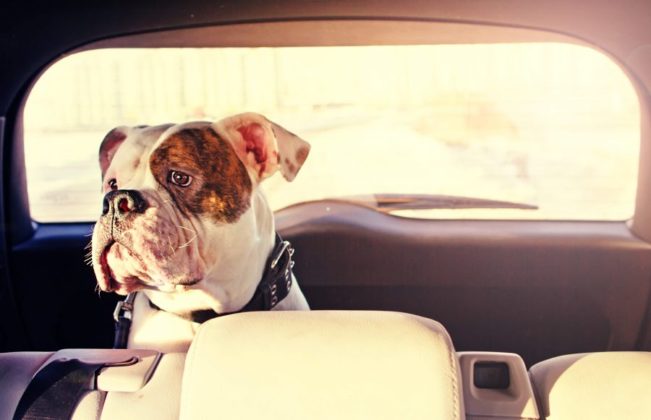Despite widespread publicity about the dangers of leaving dogs in hot cars during the summer months, people still do it. Know how to help if you spot a dog in distress.
Few things are more upsetting than seeing a dog locked in a car on a hot day, especially if he’s in obvious distress. Although animal organizations work to educate people about the dangers of leaving pets in vehicles during hot weather, not everyone is getting the message. In this article, we’ll look at what you can do to save the life of dogs shut in a hot cars.
Is it legal to break into a car to save a dog?
Most of us wouldn’t think twice about smashing a window if we saw a dog suffering inside a locked car. It seems a small price to pay to save his life. But unfortunately, very few regions in North America legally permit citizens to break into vehicles to save animals. That being said, it’s also illegal to place a dog in a distressing situation. During hot weather, whether sunny or cloudy, the temperature inside a closed vehicle will rise to extreme levels within minutes; and because dogs don’t perspire like we do, they can rapidly develop heat stroke and even die. And despite what some people think, parking in the shade or leaving the windows open a crack doesn’t help.
“Even on a day when it’s 70°F outside, the temperature inside a car with all the windows closed can hit 90°F in just ten minutes,” says Natalia Lima of the Animal Legal Defense Fund (ALDF).
Let’s take a closer look at the current rules and regulations surrounding this issue.
American laws
“[Many] states do not have ‘hot car’ laws (laws that prohibit leaving unattended animals in vehicles),” states the ALDF website. “In total, 25 states currently have some form of a ‘hot car’ law on the books.”
These legislations vary widely, however, and aren’t specific about the length of time or at what temperature a dog can be legally left in a car. And they don’t grant legal permission for citizens to break and enter a vehicle to save an animal, regardless of whether or not he’s in distress, so it’s important to call 911. “Most states allow a public safety officer to break into the car and rescue an animal if his life is threatened,” says Natalia.
Some states, such as California and Florida, do have “Good Samaritan” hot car laws (or proposed laws) that make exceptions under certain conditions, allowing citizens to take action provided they dial 911 first and use only as much force as necessary to get into the vehicle.
If you do opt to break into the vehicle yourself, the consequences depend on the situation and people involved, as well as your locale. “Most states limit penalties to misdemeanors or civil fines/infractions,” says the ALDF website. In some cases, the owner of the vehicle will drop charges out of gratitude, or for fear of public shaming, so rescuers often find themselves with limited (if any) fines to pay. In other cases, however, you may end up being sued, so don’t just assume you won’t get into trouble for breaking into a car.
Canadian laws
In Canada, the laws are similar. It is illegal for citizens to break a window to get a dog out of a vehicle. Doing so can result in a fine or other penalty. This applies to everyone, including the SPCA and the police themselves. However, Canadian police and SPCA officials receive proper procedure training, so calling them should be your first step.
As in the US, leaving an animal in a car in Canada is not an offense – the offence occurs when the animal has been placed in a harmful situation as defined under the Animal Cruelty section in the Criminal Code of Canada (e.g. life-threatening temperatures inside the vehicle). If such an offense is committed, the punishment is a fine or even imprisonment.
So what can you do?
If you see a distressed dog inside a hot car, smashing the window may seem the only course of action, even if it constitutes breaking and entering and/or property damage. But there are other ways to handle the situation. Follow these general dos and don’ts:
Don’t jump the gun. Double check to make sure you’re looking at a real dog and not a crumpled piece of clothing or stuffed animal. Appearances can be deceiving, especially if the vehicle’s windows are tinted or reflecting sunlight.
Do know the signs and symptoms of heat stroke in dogs (see sidebar).
Do note the time you first notice the dog, any symptoms he displays, as well as the make, model and license plate of the vehicle. This will help track down the owner and ensure you relay accurate information to authorities.
Do make every attempt to locate the dog’s guardian, providing the dog is not yet showing signs of distress. Head into nearby stores and have them page the owner of the vehicle.
Do call 911 or the local SPCA or police if the dog is already distressed and there isn’t time to track down the owner. They’re trained to open cars without damage, and even if they don’t make it there before the owner returns, they’ll be able to advise you on what to do in the meantime.
Do continue to monitor the dog for changes in his condition until authorities arrive or the owner returns.
Don’t start an argument. Raising awareness and educating people on the dangers of leaving dogs in hot cars is one thing, but getting into a screaming match in the parking lot isn’t helping anyone, including the dog.
Do learn your state, provincial and municipal laws regarding dogs left in hot vehicles.
If you see a dog locked in a car this summer, taking these steps will help save his life while protecting you from legal repercussions.
Help educate others
- ALDF offers sunshade for your car that bear the message: “Warning: don’t leave dogs in hot cars.” Available at aldf.org/hotcars.
- Visit nohotpets.ca to sign the pledge and help raise awareness about the dangers of leaving pets in hot cars. Use the hashtag #NoHotPets on social media to encourage others to join the movement.
- Visit humanesociety.org/assets/pdfs/pets/hot_car_flyer.pdf for a printable information flyer.
Signs of heatstroke in dogs
- Exaggerated panting
- Drooling
- Wobbly or uncoordinated movement
- Staring or glazed expression
- Muscle tremors or convulsions
- Red tongue and lips
- Vomiting

